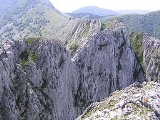
Basque mountains
Encyclopedia
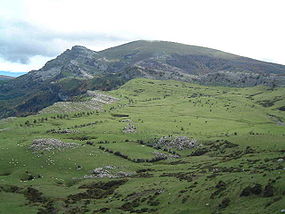
Mountain range
A mountain range is a single, large mass consisting of a succession of mountains or narrowly spaced mountain ridges, with or without peaks, closely related in position, direction, formation, and age; a component part of a mountain system or of a mountain chain...
situated in the northern Iberian Peninsula
Iberian Peninsula
The Iberian Peninsula , sometimes called Iberia, is located in the extreme southwest of Europe and includes the modern-day sovereign states of Spain, Portugal and Andorra, as well as the British Overseas Territory of Gibraltar...
. Geographically it is considered as the eastern section of the larger Cantabrian Range. The range runs through the Basque Autonomous Community
Basque Country (autonomous community)
The Basque Country is an autonomous community of northern Spain. It includes the Basque provinces of Álava, Biscay and Gipuzkoa, also called Historical Territories....
and western Navarre
Navarre
Navarre , officially the Chartered Community of Navarre is an autonomous community in northern Spain, bordering the Basque Country, La Rioja, and Aragon in Spain and Aquitaine in France...
.
Geography
The Basque Mountains are a transitional range between two major ones, the Cantabrian range to the west and the PyreneesPyrenees
The Pyrenees is a range of mountains in southwest Europe that forms a natural border between France and Spain...
to the east. Geologists call the area "The Basque threshold" and some consider that the Cantabrian Mountains and the Pyrenees are a single greater range and the Basque Mountains are just part of both
http://www.minas.upm.es/inicio/FGS/trabajos/05a04.htm.
There are two parallel sub-ranges running from west to east, the inner one and the coastal one. In between them there is a 500 m high plateau
Plateau
In geology and earth science, a plateau , also called a high plain or tableland, is an area of highland, usually consisting of relatively flat terrain. A highly eroded plateau is called a dissected plateau...
called "Llanada Alavesa" (Alava
Álava
Álava is a province of Spain and a historical territory of the Basque Country, heir of the ancient Lord of Álava. Its capital city is Vitoria-Gasteiz which is also the capital of the autonomous community...
Plains) where Vitoria-Gasteiz
Vitoria-Gasteiz
Vitoria-Gasteiz is the capital city of the province of Álava and of the autonomous community of the Basque Country in northern Spain with a population of 235,661 people. It is the second largest Basque city...
is located. East of the Llanada a narrow valley called Burunda and its follow-up Barranca (or Sakana in Basque
Basque language
Basque is the ancestral language of the Basque people, who inhabit the Basque Country, a region spanning an area in northeastern Spain and southwestern France. It is spoken by 25.7% of Basques in all territories...
) separate the two ranges, with Urbasa
Urbasa
The Urbasa Range is a mountain range of western Navarre, Spain, part of the Basque Mountains...
-Andia
Andia
The Andia Range is a mountain range of western Navarre, Spain, part of the Basque Mountains...
located to the south and Aralar
Aralar Range
Aralar aran'+'larre', meaning 'valley field') is the Basque name for a mountain range, which broadly speaking separates the province of Gipuzkoa from Navarre in the North of Spain...
to the north. The valley harbours major infrastructures linking Vitoria-Gasteiz
Vitoria-Gasteiz
Vitoria-Gasteiz is the capital city of the province of Álava and of the autonomous community of the Basque Country in northern Spain with a population of 235,661 people. It is the second largest Basque city...
and Pamplona
Pamplona
Pamplona is the historial capital city of Navarre, in Spain, and of the former kingdom of Navarre.The city is famous worldwide for the San Fermín festival, from July 6 to 14, in which the running of the bulls is one of the main attractions...
.
Climate
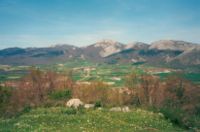
Water divide
A drainage divide, water divide, divide or watershed is the line separating neighbouring drainage basins...
of the Mediterranean and Atlantic basins, the climate north of the range is milder and oceanic
Oceanic climate
An oceanic climate, also called marine west coast climate, maritime climate, Cascadian climate and British climate for Köppen climate classification Cfb and subtropical highland for Köppen Cfb or Cwb, is a type of climate typically found along the west coasts at the middle latitudes of some of the...
, typical of the so-called green Spain
Green Spain
Green Spain is the name given to the Spanish northern maritime façade exposed to the Atlantic Ocean in Galicia which also runs along the coastal strip lying north of the Cantabrian and Basque mountains, along the Bay of Biscay...
, while to the south of the coastal range and in the inner range winters are cold and snowy and summers drier and hotter than in the northern range, in general the climate in the Basque municipalities south of this range is more Mediterranean with some Continental traits, showing less precipitation and much colder winters than those coastal municipalities north of the range.
The snow
Snow
Snow is a form of precipitation within the Earth's atmosphere in the form of crystalline water ice, consisting of a multitude of snowflakes that fall from clouds. Since snow is composed of small ice particles, it is a granular material. It has an open and therefore soft structure, unless packed by...
cover is very irregular during the winter season. From November to April snow cover can be found in the Basque Mountains above 700 m AMSL, but the ever changing weather conditions of the Bay of Biscay
Bay of Biscay
The Bay of Biscay is a gulf of the northeast Atlantic Ocean located south of the Celtic Sea. It lies along the western coast of France from Brest south to the Spanish border, and the northern coast of Spain west to Cape Ortegal, and is named in English after the province of Biscay, in the Spanish...
can bring great accumulations of snow and a sudden rise of temperatures can melt it in a few days due to the Foehn wind effect. This sudden melting can cause flooding problems, specially in the plains of northern Alava
Álava
Álava is a province of Spain and a historical territory of the Basque Country, heir of the ancient Lord of Álava. Its capital city is Vitoria-Gasteiz which is also the capital of the autonomous community...
.
Massifs
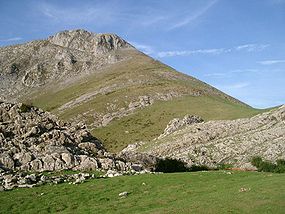

Massif
In geology, a massif is a section of a planet's crust that is demarcated by faults or flexures. In the movement of the crust, a massif tends to retain its internal structure while being displaced as a whole...
is the highest peak.
- In the inner range the main massifs from west to east are:
- Sierra Salbada (OrduñaOrduñaOrduña is a town and municipality of 4,057 inhabitants located in the province of Biscay, in the autonomous community of Basque Country, in the North of Spain....
) - Mounts of Gasteiz, the most important is Kapildui (1,177 m)
- Izki
- UrbasaUrbasaThe Urbasa Range is a mountain range of western Navarre, Spain, part of the Basque Mountains...
, a 1,000 m high plateauPlateauIn geology and earth science, a plateau , also called a high plain or tableland, is an area of highland, usually consisting of relatively flat terrain. A highly eroded plateau is called a dissected plateau... - AndíaAndiaThe Andia Range is a mountain range of western Navarre, Spain, part of the Basque Mountains...
, with the impressive BeriainBeriainBeriain is a 1,493 metres high peak part of the Basque Mountains range, located in the Andia range of western Navarre, Spain. Its sharp profile is an iconic image in the Burunda and Barranca valleys that link Vitoria-Gasteiz and Pamplona. The peak is located at the center of the traditional Basque...
(1,493 m)
- Sierra Salbada (Orduña
- In the coastal range its main massifs from west to east are:
- GorbeaGorbeaGorbea or Gorbeia is a mountain and massif, the highest in Biscay and Alava , with a height of 1,481 m AMSL. The massif covers a wide area between the two provinces. The main mountain is a round grass-covered summit where a 20-metre-tall metallic cross has been constructed to reach the altitude of...
(Gorbeia) 1,481 m, maximum height of BiscayBiscayBiscay is a province of Spain and a historical territory of the Basque Country, heir of the ancient Lord of Biscay. Its capital city is Bilbao...
. - UrkiolaUrkiolaUrkiola is a mountain range of the Basque mountains in Biscay near Durango, in the western Basque Country, Spain. The range's highest mountain is Anboto...
, AnbotoAnbotoAnboto is a limestone mountain of the Western Basque Country, the highest peak of the Urkiola range and not far from the pass of Urkiolamendi between Durango and Vitoria-Gasteiz.- Description :...
(1,331 m) being its highest peak. - Elgea
- Aizkorri
- Altzania, the AratzAratzAratz is a mountain of the Basque Country located at the mountain range Altzania that provides the extension for the massif Aizkorri, in the country of Spain...
is the maximum height (1,442 m). - Aralar, its most known peak being TxindokiTxindokiTxindoki or Larrunarri is an iconic mountain located in the region of Goierri, Gipuzkoa, in the Basque Autonomous Community of Spain. Originally Larrunarri or Ñañarri ], the mount took on the popularized name Txindoki by extension after some shepherd huts nearby...
(1,346 m)
- Gorbea
Other important mountains nearer the sea include Ganekogorta
Ganekogorta
Ganekogorta is a mountain in the border of the provinces of Biscay and Alava , just between Bilbao and Llodio. It has a height of 998 m AMSL and it's the main peak of a massif that comprises some smaller mountains like Pagasarri, Ganeta, Pasatorenkorta, Arnotegi or Arraiz...
, Oiz
Oiz
Mount Oiz , is one of the most popular summits of Biscay in the Basque Country . Its summits form part of a long range that feeds several rivers: Ibaizabal, Artibai, Lea, Oka and Deva in Gipuzkoa all of them running to the Bay of Biscay....
, Sollube, Arrate, Kalamua and Hernio
Hernio
Hernio is an iconic summit in the Basque Country very popular with the Gipuzkoans and located right at the heart of the province. The peak is the highest point of a massif extending north-west to south-east, the summit rising by the pass of Zelatun...
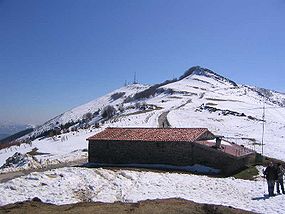
Nature
The range is almost entirely limestoneLimestone
Limestone is a sedimentary rock composed largely of the minerals calcite and aragonite, which are different crystal forms of calcium carbonate . Many limestones are composed from skeletal fragments of marine organisms such as coral or foraminifera....
, but other materials can be found.
The slopes are generally gentle, but there are many limestone peaks and cliffs in which vultures dwell.
There is abundant oceanic climate
Oceanic climate
An oceanic climate, also called marine west coast climate, maritime climate, Cascadian climate and British climate for Köppen climate classification Cfb and subtropical highland for Köppen Cfb or Cwb, is a type of climate typically found along the west coasts at the middle latitudes of some of the...
vegetation, like beeches, oak
Oak
An oak is a tree or shrub in the genus Quercus , of which about 600 species exist. "Oak" may also appear in the names of species in related genera, notably Lithocarpus...
s, birch
Birch
Birch is a tree or shrub of the genus Betula , in the family Betulaceae, closely related to the beech/oak family, Fagaceae. The Betula genus contains 30–60 known taxa...
es and other like the Cantabrian Holm Oak
Holm Oak
Quercus ilex, the Holm Oak or Holly Oak is a large evergreen oak native to the Mediterranean region. It takes its name from holm, an ancient name for holly...
s and the Pinus radiata, the last one artificially introduced for plantation
Plantation
A plantation is a long artificially established forest, farm or estate, where crops are grown for sale, often in distant markets rather than for local on-site consumption...
.

